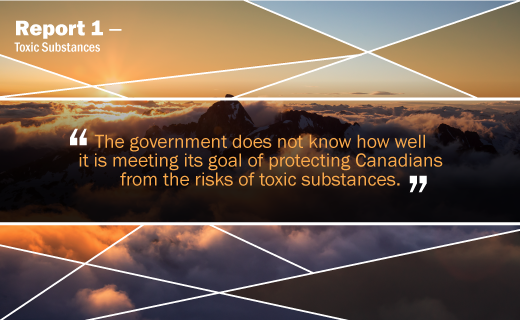Report 1—Toxic Substances
At a Glance Report 1—Toxic Substances
What we examined (see Focus of the audit)
Canadians use many goods and services that can release toxic substances. Exposure to these substances from computers, fabrics, fuels, dry cleaning, and other goods and services may lead to a variety of serious health issues—including cancer, autoimmune diseases, and nerve disorders. These substances can also affect wildlife and the quality of Canada’s air, soil, and water.
This audit focused on whether Environment and Climate Change Canada enforced regulations under the Canadian Environmental Protection Act, 1999 to control the risks of toxic substances. We examined six toxic substances to determine whether Environment and Climate Change Canada and Health Canada had evaluated their progress in meeting objectives for reducing risks to the environment and human health. We also examined whether the departments communicated the risks of toxic substances to the public.
Why we did this audit
This audit is important because Canadians depend on the federal government to reduce the risks of toxic substances to human health and the environment, and to communicate these risks.
Overall message
Overall, we found that despite long-standing efforts, Environment and Climate Change Canada and Health Canada still had significant work to do in selected areas to effectively control the risks of toxic substances and to inform Canadians about those risks.
Environment and Climate Change Canada had improvements to make in some aspects of its approach to enforcing toxic substance regulations under the Canadian Environmental Protection Act, 1999. The department conducted inspections and other enforcement activities to ensure that businesses complied with regulations on toxic substances, but in most cases, it did not base its enforcement priorities on risks to human health and the environment. For example, some 2,200 of the more than 10,000 inspections the Department carried out during the 2014–15 to 2016–17 fiscal years targeted a single toxic substance used by dry cleaners. However, there was no documented evidence that this substance presented a higher risk to human health or the environment than other substances.
In addition, Environment and Climate Change Canada had not fully addressed selected recommendations from our previous audits. The Department lacked timely access to information about which businesses were regulated, had not yet set time frames to follow up on violations, and had not addressed all of the enforceability issues it had identified in regulations.
Furthermore, Environment and Climate Change Canada and Health Canada had not completed work to address our 2009 recommendation to assess whether they were meeting their overall objectives to reduce the risks of toxic substances to human health and the environment.
Both Health Canada and Environment and Climate Change Canada play a role in informing the public about health and environmental risks from toxic substances. We found that information on Health Canada’s website was often unclear and difficult to find.
For example, visitors to Health Canada’s home page had to click through several web pages for information about toxic substances and then navigate to a different Government of Canada website to access “Chemicals at a glance.” Environment and Climate Change Canada’s communication activities to explain environmental risks were limited. These weaknesses made it difficult for Canadians to find information to make informed choices about toxic substances.
What we found about…
Enforcing regulations
Evaluating progress
Informing the public
Entity Responses to Recommendations
The audited entities agree with our recommendations and has responded (see List of Recommendations).
Related Information
| Report of the | Commissioner of the Environment and Sustainable Development |
|---|---|
| Type of product | Performance audit |
| Topics | |
| Entities | |
| Completion date | 4 July 2018 |
| Tabling date | 2 October 2018 |
| Related audits |
|
For more information
Media Relations
Telephone.: 1-888-761-5953
E-mail: infomedia@oag-bvg.gc.ca
Twitter: OAG_BVG
